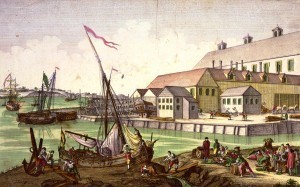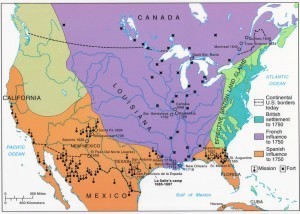Colonial Families of the Eastern Shore of Virginia Vol. 3

The American Revolution unfolded in thirteen British colonies clustered the eastern coastline of North America. These 13 colonies were explored, settled and colonised over more than than a century, beginning in 1607 (Virginia) and concluding in 1732 (Georgia). To empathize the causes of the American Revolution requires an understanding of the xiii colonies and their development and experiences in the colonial period, specially their human relationship with Britain.
Motives for colonisation
Each of the 13 British colonies in America began with a land merits, followed past exploration and settlement past a British company or trek group. The main factor behind the British colonisation of America was gold. Similar the Spanish in South America, British explorers and settlers hoped to discover large deposits of gold or other precious minerals.
When big gilt deposits could not be constitute, land and natural resources replaced gilded as an incentive for colonisation, settlement and migration. Available land was extremely scarce in Europe because it was monopolised by wealthy royals and aristocrats. It was far more abundant in the New World, allowing settlers to become freeholders or yeoman farmers rather than mere tenants.
The abundance of raw materials in North America was some other potential source of profit. Timber, rice, grain, tobacco, cotton, indigo, furs, fish and other commodities could be harvested or grown in affluence in America. The availability of alpine timber provided the materials for the colonial shipbuilding manufacture. Later, the discovery of fe ore encouraged the formation of local ironworking foundries.
Population
Over fourth dimension, the 13 colonies were populated with Europeans and slaves imported from Africa. Immigration increased steadily in the 17th and 18th centuries. In 1640, there were fewer than 25,000 Europeans in British America. This increased to more than 70,000 by 1660 and around 150,000 in 1680. Past the outbreak of the French and Indian War in 1754, the European population was approaching two million.
Working-grade Europeans arriving in the New World found life there more prosperous and comfortable. Farming state was readily available, nutrient was plentiful and living standards were better than those of Europe.
Immigration connected quickly, fifty-fifty at the height of the Revolutionary War. In addition to European population growth, almost 300,000 African-American slaves were landed in the British colonies between 1620 and the outbreak of the revolution in 1765. Another half-million people arrived in British America every bit indentured servants.
Common heritage
As part of the British Empire, the 13 colonies shared some common heritage, attitudes and institutions. Because of this – and because they later on joined together in revolution – many retrieve of these colonies as a unified and homogenous group. This was far from the case.
All 13 colonies were marked past differences in geography, climate, natural resources, population, economic production and how they were governed. Intercolonial tensions were non uncommon and were usually fuelled by disputes over trade, borders and country claims.
Despite these differences and tensions, the British colonies in America were mostly seen as a place of hope, opportunity and potential prosperity. The colonies' biggest advantage was their distance from Europe and freedom from old European hierarchies and systems of power. The botanist John Bartram, who travelled extensively throughout the region, wrote of the British colonies in 1751:
"England already has an uninterrupted line of well-peopled provinces on the coast, successively begun within less than 150 years. Every year they are augmented past an accession of subjects, excited by the desire of living under governments and laws formed on the most splendid model upon world. In vain practice we await for an equal prosperity among the plantations of other European nations… This surprising increment of people is a foundation that will bear a mighty superstructure."
Economics and production

The economies of British America were focused chiefly on agronomics and primary product. The vast majority of colonists lived in rural and provincial areas and worked on plantations, farms or harvesting natural resources.
Though agronomics was dominant across all 13 colonies, there was considerable variation from region to region. In New England, the six northernmost colonies, prepare and whale oil made up almost half of exports, with fur, leather, timber and livestock also traded heavily. The more temperate weather in the Centre Colonies meant nutrient grains constituted well-nigh three-quarters of exports, while in the South, tobacco and rice fabricated up almost 70% of goods exported.
Manufacturing grew considerably through the 1700s but was largely confined to modest enterprises. British mercantilist legislation similar the Fe Deed (1750) discouraged or prohibited the formation of large operations that could rival or supercede British companies. Many secondary goods such as wear, article of furniture, machinery and weapons were still imported from England.
Life in the colonies
This lack of major industries meant American cities remained insufficiently pocket-sized. The bulk of colonists lived in small communities, towns, villages or on the frontier. Distances, poor roads and the fright of native attacks meant that few travelled far from their hometown.
This meant that most colonists lived relatively contained lives removed from the control or interference of governments, both their own colonial assemblies and the parliament in London. Equally mentioned above, living standards were generally superior to Europe. This led to improvements in education and literacy, which was much higher in colonial America than in Europe (up to 85 per cent in some places).
In general, Americans did not think themselves "Americans"; they were yet to develop whatever sense of nationalism or American identity. Instead, well-nigh considered themselves British subjects and natives of their colony (Virginians, South Carolinians, Marylanders and then forth).
Foreign neighbours

The thirteen British colonies were non alone on the continent. 3 other European powers laid merits to territory in Northward America and shared borders with the British.
The Spanish were the first to arrive in North America, following Christopher Columbus' famous expedition that 'discovered' North America in 1492. The French began exploring the continent in 1524 and, by the end of the century, were attempting permanent settlements.
The Dutch also deputed exploration of the Due north American coastline (1609) and initiated settlements xiv years later. By 1660, the Dutch controlled the area now occupied by New Jersey and eastern New York state. They surrendered their American colonies to England in 1667, after defeat in the Second Anglo-Dutch War.
By 1750, some lxxx per cent of the Due north American continent was controlled or influenced by French republic or Spain (see map above). Their presence was a source of tension and paranoia among those in the 13 British colonies, who feared encirclement, invasion and the influence of Catholicism.

i. The scene of the American Revolution was 13 British colonies that were located along the eastern seaboard of North America.
ii. These colonies were founded and settled individually past British expeditions and companies, beginning with Virginia (1609) and Massachusetts (1620).
3. Initially claimed in the search for aureate, the colonies became a lucrative source of country and raw materials, both of which were less accessible in crowded Europe.
4. The colonies flourished in the 17th and 18th centuries. The availability of state, work and resources saw increased emigration and rapid population increases, from just 55,000 in 1650 to more than than ii million by the outbreak of the revolution.
five. Despite their growth and progress the 13 British colonies occupied only xx per cent of the North American continent. The balance was controlled or influenced by France and Kingdom of spain. Their existence contributed to political and religious tensions.
Citation data
Title: "The Xiii Colonies"
Authors: Jennifer Llewellyn, Steve Thompson
Publisher: Alpha History
URL: https://alphahistory.com/americanrevolution/13-colonies/
Date published: September 3, 2020
Engagement accessed: February 14, 2022
Copyright: The content on this page may not be republished without our express permission. For more information on usage, please refer to our Terms of Use.
Source: https://alphahistory.com/americanrevolution/thirteen-colonies/
0 Response to "Colonial Families of the Eastern Shore of Virginia Vol. 3"
Post a Comment